

Writer Guide
Chapter
1
Introducing Writer
This document is Copyright © 2011 by its contributors as listed below. You may distribute it and/or modify it under the terms of either the GNU General Public License (http://www.gnu.org/licenses/gpl.html), version 3 or later, or the Creative Commons Attribution License (http://creativecommons.org/licenses/by/3.0/), version 3.0 or later.
All trademarks within this guide belong to their legitimate owners.
Contributors
Barbara
Duprey John M. Długosz
Ron
Faile Jr. Hal Parker
Feedback
Please direct any comments or suggestions about this document to: documentation@libreoffice.org
Acknowledgments
This chapter is based on Chapter 1 of the Writer Guide for OpenOffice.org. The contributors to that chapter are:
Agnes
Belzunce Daniel Carrera Laurent Duperval
Stefan A. Keel Peter
Kupfer Carol Roberts
Joe Sellman Gary Schnabl Janet M.
Swisher
Jean Hollis Weber Linda Worthington Michele Zarri
Publication date and software version
Published 15 March 2011. Based on LibreOffice 3.3.
Some keystrokes and menu items are different on a Mac from those used in Windows and Linux. The table below gives some common substitutions for the instructions in this chapter. For a more detailed list, see the application Help.
|
Windows/Linux |
Mac equivalent |
Effect |
|
Tools → Options menu selection |
LibreOffice → Preferences |
Access setup options |
|
Right-click |
Control+click |
Opens context menu |
|
Ctrl (Control) |
z (Command) |
Used with other keys |
|
F5 |
Shift+z+F5 |
Opens the Navigator |
|
F11 |
z+T |
Opens Styles & Formatting window |
Contents
Parts of the main Writer window 4
Starting a new document from a template 13
Opening an existing document 13
Saving a document automatically 14
Saving as a Microsoft Word document 14
Moving quickly through a document 19
Using the Navigation toolbar 19
Rearranging chapters using the Navigator 20
Writer is the word processor component of LibreOffice. It provides the usual features of a word processor: enter and edit text, spelling check, thesaurus, hyphenation, autocorrect, find and replace, automatic generation of tables of contents and indexes, mail merge, and others.
In addition, Writer provides these important features:
Templates and styles (see Chapters 6 and 7)
Page-layout methods, including frames, columns, and tables (Chapter 4)
Embedding or linking of graphics, spreadsheets, and other objects (Chapter 8)
Built-in drawing tools (Chapter 8)
Master documents, to group a collection of documents into a single document (Chapter 13)
Change tracking during revisions (Chapter 3)
Database integration, including a bibliography database (Chapters 11, 12, 15)
Export to PDF, including bookmarks (Chapter 5)
And many more
Styles are central to using Writer. Using styles, you can easily format your document consistently and change the format with minimal effort. A style is a named set of formatting options. Writer defines several types of styles, for different types of elements: characters, paragraphs, pages, frames, and lists. Often, you are using styles whether you realize it or not. The use of styles is described in more detail in Chapter 6, Introduction to Styles, and Chapter 7, Working with Styles.
Parts of the main Writer window
The main Writer workspace is shown in Figure 1. Its features are described in this section.
The Title bar is located at the top of the Writer window, and shows the file name of the current document. When the document is newly created, the document name will appear as Untitled X, where X is a number.
The Menu bar is located just below the Title bar. When you choose one of the menus listed below, a submenu drops down to show commands.
File contains commands that apply to the entire document such as Open, Save, Print, and Export as PDF.
Edit contains commands for editing the document such as Undo: xxx (where xxx is the command to undo) and Find & Replace. It also contains commands to Cut, Copy, and Paste selected parts of your document.
View contains commands for controlling the display of the document such as Zoom and Web Layout.
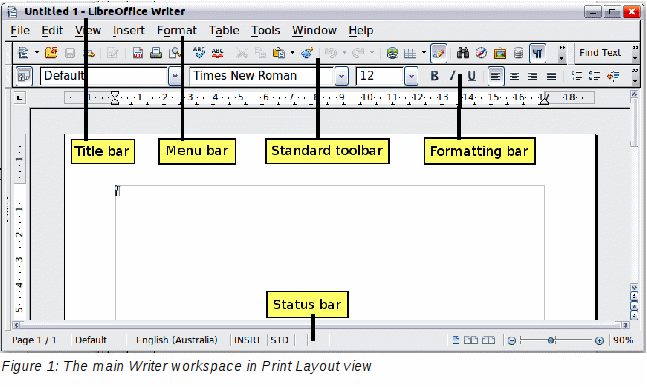
Insert contains commands for inserting elements into your document such as headers, footers, and pictures.
Format contains commands, such as Styles and Formatting, Paragraph, and Bullets and Numbering, for formatting the layout of your document
Table shows all commands to insert and edit a table in a text document.
Tools contains functions such as Spelling and Grammar, Customize, and Options.
Window contains commands for the display window.
Help contains links to the LibreOffice Help file, What’s This?, and information about the program. See “Getting help” on page 22.
Writer has several types of toolbars: docked (fixed in place), floating, and tear-off. Docked toolbars can be moved to different locations or made to float, and floating toolbars can be docked.
The top toolbar, just under the Menu bar, is called the Standard toolbar. It is consistent across the LibreOffice applications (Writer, Calc, Draw, Impress).
The second toolbar at the top is the Formatting bar. It is context-sensitive; that is, it shows the tools relevant to the cursor’s current position or selection. For example, when the cursor is on a graphic, the Formatting bar provides tools for formatting graphics; when the cursor is in text, the tools are for formatting text.
To display or hide toolbars, choose View → Toolbars, then click on the name of a toolbar in the list. An active toolbar shows a check mark beside its name. Tear-off toolbars are not listed in the View menu.
Submenus and tear-off toolbars
Toolbar icons with a small triangle to the right will display submenus, tear-off toolbars, and other ways of selecting things, depending on the tool.
An example of a tear-off toolbar is shown in Figure 2. Tear-off toolbars can be floating or docked along an edge of the screen or in one of the existing toolbar areas. To move a floating tear-off toolbar, drag it by the title bar, as shown in Figure 4.
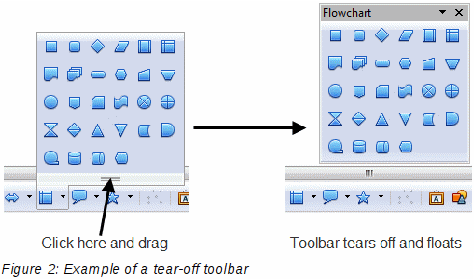
To move a docked toolbar, place the mouse pointer over the toolbar handle, hold down the primary mouse button, drag the toolbar to the new location, and then release the mouse button.


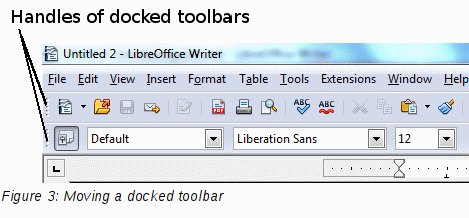
To move a floating toolbar, click on its title bar and drag it to a new location.

Writer includes several additional context-sensitive toolbars, whose defaults appear as floating toolbars in response to the cursor’s current position or selection. For example, when the cursor is in a table, a floating Table toolbar appears, and when the cursor is in a numbered or bullet list, the Bullets and Numbering toolbar appears. You can dock these toolbars to the top, bottom, or side of the window, if you wish (see “Moving toolbars” on page 6).
Docking/floating windows and toolbars
Toolbars and some windows, such as the Navigator and the Styles and Formatting window, are dockable. You can move, resize, or dock them to an edge.
To dock a window or toolbar, hold down the Control key and double-click on the frame of the floating window (or in a vacant area near the icons at the top of the floating window) to dock it in its last position.
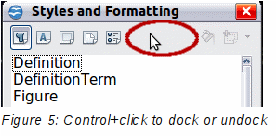
To undock a window, hold down the Control key and double-click on the frame (or a vacant area near the icons at the top) of the docked window.
You can customize toolbars in several ways, including choosing which icons are visible and locking the position of a docked toolbar.
To access a toolbar’s customization options, click the downward-pointing arrow icon at the end of the toolbar or on its title bar (Figure 6).
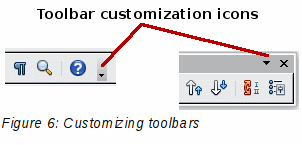
To show or hide icons defined for the selected toolbar, choose Visible Buttons from the drop-down menu. Visible icons are indicated by a border around the icon (Figure 7). Click on icons to hide or show them on the toolbar.
You can also add icons and create new toolbars, as described in Chapter 16, Customizing Writer.
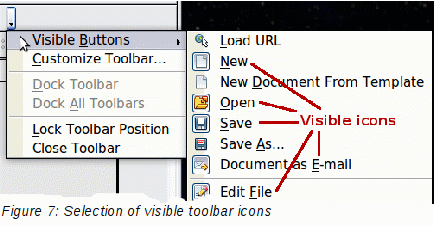
Right-click on a paragraph, graphic, or other object to open a context menu. Often the context menu is the fastest and easiest way to reach a function. If you’re not sure where in the menus or toolbars a function is located, you can often find it by right-clicking.
To show or hide rulers, choose View → Ruler. To enable the vertical ruler, choose Tools → Options → LibreOffice Writer → View and select Vertical ruler.
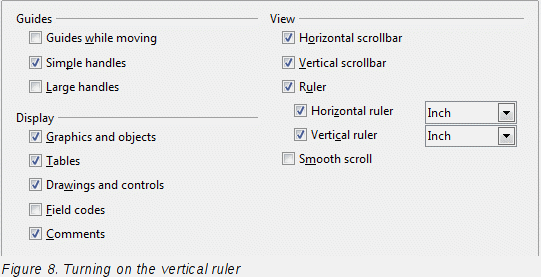
The Writer status bar is located at the bottom of the workspace. It provides information about the document and convenient ways to quickly change some document features.


Page number
Shows the current page number, the sequence number of the current page (if different from the page number), and the total number of pages in the document. For example, if a document has 14 pages and you restarted page numbering at 1 on the third page, its page number is 1, its sequence number is 3, and the total number of pages is 14; this field would show 1 3/14.
If any bookmarks have been defined in the document, a right-click on this field pops up a list of bookmarks; click on the required one to go to the bookmark.
To jump to a specific page in the document, double-click on this field. The Navigator opens (see page 17). Click in the Page Number field in the Navigator and type the sequence number of the required page. After a brief delay, the display jumps to the selected page.
Page style
Shows the style of the current page. To change the page style, right-click on this field. A list of page styles pops up; choose a different style by clicking on it.
To edit the current page style, double-click on this field. The Page Style dialog box opens. See Chapters 6 and 7 in this book for more information about styles.
Language
Shows the language for the selected text.
Click to open a menu where you can choose another language for the selected text or for the paragraph where the cursor is located. You can also choose None (Do not check spelling) to exclude the text from a spelling check or choose More to open the Character dialog box. See Chapter 3, Working with Text, for more information.
Insert mode
Click to toggle between Insert and Overwrite modes when typing. In Insert mode, any text after the cursor position moves forward to make room for the text you type; in Overwrite mode, text after the cursor position is replaced by the text you type.
Selection mode
Click to toggle between STD (Standard), EXT (Extend), ADD (Add) and BLK (Block) selection. EXT is an alternative to Shift+click when selecting text. See Chapter 3, Working with Text, for more information about these modes.
Unsaved changes
An
icon
![]() appears here if changes to the document have not been saved.
appears here if changes to the document have not been saved.
Digital signature
If
the document has been digitally signed, an icon
![]() shows here. To view the certificate, double-click the icon.
shows here. To view the certificate, double-click the icon.
Section or object information
When the cursor is in a section, heading, or list item, or when an object (such as a picture or table) is selected, information about that item appears in this field. Double-clicking in this area opens a relevant dialog box.
|
Object |
Information shown |
Dialog box opened |
|
Picture |
Size and position |
Picture |
|
List item |
Level and list style |
Bullets and Numbering1 |
|
Heading |
Outline numbering level |
Bullets and Numbering1 |
|
Table |
Name or number and cell reference of cursor |
Table Format |
|
Section |
Name of section |
Edit Sections |
|
Other |
(Blank) |
Fields |
View layout
Click an icon to change between single page, side-by-side, and book layout views. (See Figure 11.) You can edit the document in any view. Zoom settings (see below and next page) interact with the selected view layout to determine how many pages are visible in the document window.
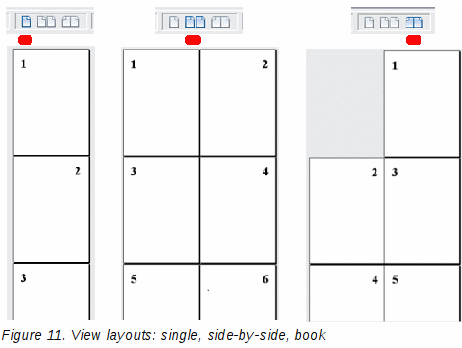
Zoom
To change the view magnification, drag the Zoom slider, or click on the + and − signs, or right-click on the zoom level percent to pop up a list of magnification values from which to choose.
![]()
Writer has three ways to view a document: Print Layout, Web Layout, and Full Screen. To change the view, go to the View menu and click on the required view.
Print Layout is the default view in Writer. In this view, you can use the Zoom slider and the View Layout icons on the Status bar to change the magnification.
You can also choose View → Zoom from the menu bar to display the Zoom & View Layout dialog box, where you can set the same options as on the Status bar.
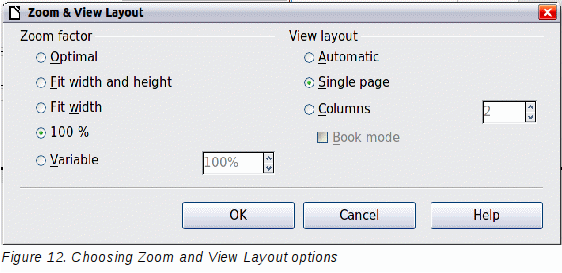
In Web Layout view, you can use the Zoom slider; the View Layout buttons on the Status bar are disabled, and most of the choices on the Zoom & View Layout dialog box are not available.
In Full Screen view, the document is displayed using the zoom and layout settings previously selected. To exit Full Screen view and return to either Print or Web Layout view, press the Esc key or click the Full Screen icon in the top left-hand corner. You can also use Ctrl+Shift+J to enter or exit Full Screen view.
You can start a new, blank document in Writer in several ways.
From the operating system menu, in the same way that you start other programs. When LibreOffice was installed on your computer, in most cases a menu entry for each component was added to your system menu. If you are using a Mac, you should see the LibreOffice icon in the Applications folder. When you double-click this icon, LibreOffice opens at the Start Center (Figure 14).
From the Quickstarter, which is found in Windows, some Linux distributions, and (in a slightly different form) in Mac OS X. The Quickstarter is an icon that is placed in the system tray or the dock during system startup. It indicates that LibreOffice has been loaded and is ready to use.
Right-click the Quickstarter icon (Figure 13) in the system tray to open a pop-up menu from which you can open a new document, open the Templates and Documents dialog box, or choose an existing document to open. You can also double-click the Quickstarter icon to display the Templates and Documents dialog box.
See Chapter 1, Introducing LibreOffice, in the Getting Started guide for more information about starting Writer and using the Quickstarter.
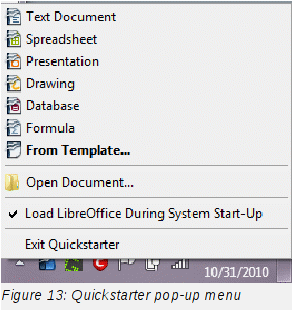
From the Start Center. When LibreOffice is open but no document is open (for example, if you close all the open documents but leave the program running), the Start Center is shown. Click one of the icons to open a new document of that type, or click the Templates icon to start a new document using a template. If a document is already open in LibreOffice, the new document opens in a new window.
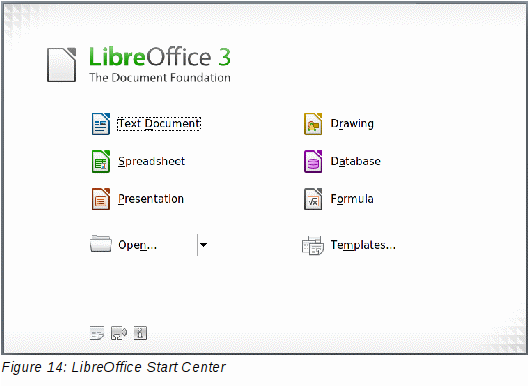
When LibreOffice is open, you can also start a new document in one of the following ways.
Press the Control+N keys.
Use File → New → Text Document.
Click the New button on the main toolbar.
Starting a new document from a template
You can use templates to create new documents in Writer. A template is a set of predefined styles and formatting. Templates serve as the foundation of a set of documents, to make sure they all have a similar layout. For example, all the documents of the Writer Guide are based on the same template. As a result, all the documents look alike; they have the same headers and footers, use the same fonts, and so on.
A new LibreOffice installation does not contain many templates. It is possible for you to add new templates to your installation and use them for new documents. This is explained in Chapter 10, Working with Templates. Many more templates can be downloaded from http://extensions.libreoffice.org/ and other websites.
Once you have templates on your system, you can create new documents based on them by using File → New → Templates and Documents. This opens a window where you can choose the template you want to use for your document.
The example shown in Figure 15 uses a template in the My Templates folder. Select it, then click the Open button. A new document is created based on the styles and formats defined in the template.
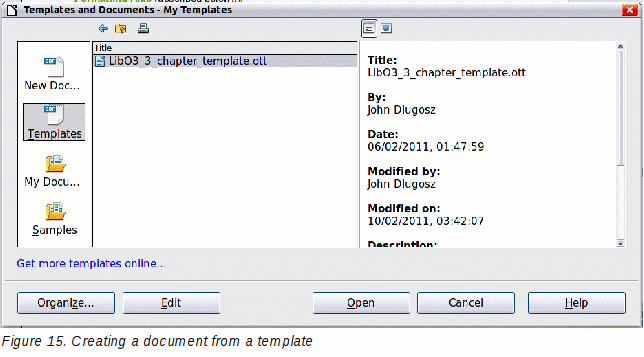
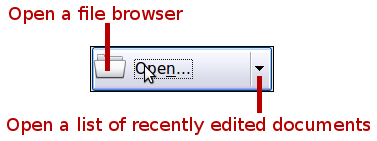
When
no document is open, the Start
Center (Figure 14) provides an icon for
opening an existing document or choosing from a list of
recently-edited documents.
You can also open an existing document in one of the following ways. If a document is already open in LibreOffice, the second document opens in a new window.
Choose File → Open.
Click the Open button on the main toolbar.
Press Control+O on the keyboard.
Use the Open Document or Recent Documents selections on the Quickstarter.
In each case, the Open dialog box appears. Select the file you want, and then click Open. If a document is already open in LibreOffice, the second document opens in a new window.
In the Open dialog box, you can reduce the list of files by selecting the type of file you are looking for. For example, if you choose Text documents as the file type, you will only see documents Writer can open (including *.odt, *.doc, *.txt). This method opens Word (*.doc) files as well as LibreOffice files and other formats.
You can also open an existing Writer document using the same methods you would use to open any document in your operating system.
If you have associated Microsoft Office file formats with LibreOffice, you can also open these files by double-clicking on them.
To save a new document in Writer, do one of the following:
Press Control+S.
Choose File → Save.
Click the Save button on the main toolbar.
When the Save As dialog box appears, enter the file name, verify the file type (if applicable), and click Save.
To save an open document with the current file name, choose File → Save. This will overwrite the last saved state of the file.
Saving a document automatically
You can choose to have Writer save your document automatically at regular intervals. Automatic saving, like manual saving, overwrites the last saved state of the file. To set up automatic file saving:
Select Tools → Options → Load/Save → General.
Click on Save AutoRecovery information every and set the time interval. The default value is 15 minutes. Enter the value you want by typing it or by pressing the up or down arrow keys.
Saving as a Microsoft Word document
If you need to exchange files with users of Microsoft Word, they may not know how to open and save .odt files. Microsoft Word 2007 with Service Pack 2 (SP2) can do this. Users of Word 2007, 2003, XP, and 2000 can also download and install a free OpenDocument Format (ODF) plugin from Sun Microsystems, available from Softpedia, http://www.softpedia.com/get/Office-tools/Other-Office-Tools/Sun-ODF-Plugin-for-Microsoft-Office.shtml.
Some users of Microsoft Word may be unwilling or unable to receive *.odt files. (Perhaps their employer won’t allow them to install the plug-in.) In this case, you can save a document as a Microsoft Word file.
Important—First save your document in the file format used by LibreOffice Writer, *.odt. If you do not, any changes you made since the last time you saved will only appear in the Microsoft Word version of the document.
Then click File → Save As.
On the Save As dialog box, in the File type (or Save as type) drop-down menu, select the type of Word format you need.
Click Save.
From this point on, all changes you make to the document will occur only in the Microsoft Word document. You have changed the name and file type of your document. If you want to go back to working with the *.odt version of your document, you must open it again.
|
Tip |
To have Writer save documents by default in the Microsoft Word file format, go to Tools → Options → Load/Save → General. In the section named Default file format and ODF settings, under Document type, select Text document, then under Always save as, select your preferred file format. |
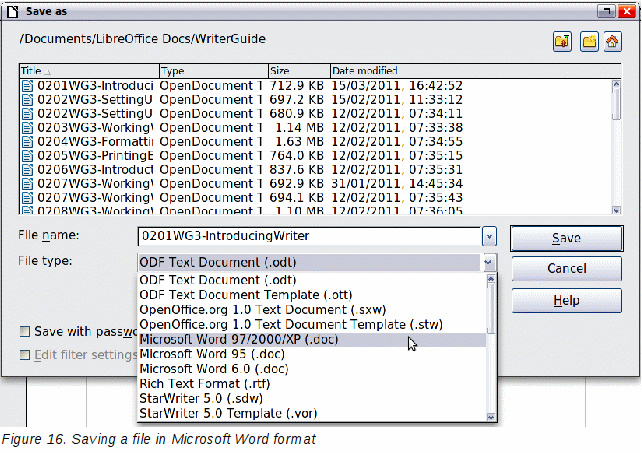
Writer provides two levels of document protection: read-protect (file cannot be viewed without a password) and write-protect (file can be viewed in read-only mode but cannot be changed without a password). Thus you can make the content available for reading by a selected group of people and for reading and editing by a different group. This behavior is compatible with Microsoft Word file protection.
Use File → Save As when saving the document. (You can also use File → Save the first time you save a new document.)
On the Save As dialog box, select the Save with password option, and then click Save.
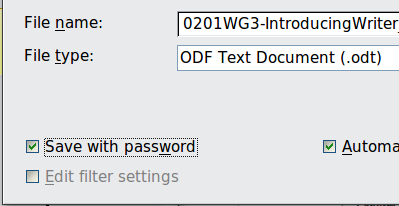
The Set Password dialog box opens.
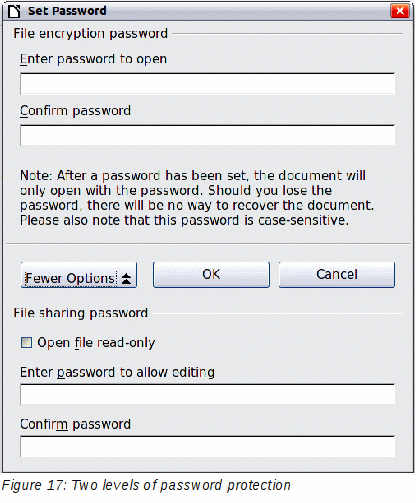
Here you have several choices:
To read-protect the document, type a password in the two fields at the top of the dialog box.
To write-protect the document, click the More Options button and select the Open file read-only checkbox.
To write-protect the document but allow selected people to edit it, select the Open file read-only checkbox and type a password in the two boxes at the bottom of the dialog box.
Click OK to save the file. If either pair of passwords do not match, you receive an error message. Close the message box to return to the Set Password dialog box and enter the password again.
|
Caution
|
LibreOffice uses a very strong encryption mechanism that makes it almost impossible to recover the contents of a document if you lose the password. |
To close a document, choose File → Close or click the Close icon on the document window. The appearance and placement of this icon varies with your operating system, but it typically looks like the X in the red box shown in Figure 18.
If more than one LibreOffice window is open, each window looks like the sample shown on the left in Figure 18. Closing this window leaves the other LibreOffice windows open.
If only one LibreOffice window is open, it looks like the sample shown on the right in Figure 18. Notice the small black X below the larger X in the red box. Clicking the small black X closes the document but leaves LibreOffice open. Clicking the larger X closes LibreOffice completely.
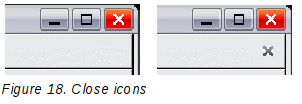
If the document has not been saved since the last change, a message box is displayed. Choose whether to save or discard your changes.
Save: The document is saved and then closed.
Discard: The document is closed, and all modifications since the last save are lost.
Cancel: Nothing happens, and you return to the document.
To close LibreOffice completely, click File → Exit, or close the last open document as described in “Closing a document” above.
If all the documents have been saved, Writer closes immediately. If any documents have been modified but not saved, a warning message appears. Follow the procedure in “Closing a document” to save or discard your changes.
In addition to the Page Number field on the Status bar (described on page 8), Writer provides other ways to move quickly through a document and find specific items by using the many features of the Navigator, the Navigation toolbar, and related icons.
The Navigator lists all of the headings, tables, text frames, graphics, bookmarks, and other objects contained in a document.
To
open the Navigator,
click its icon
![]() on the Standard toolbar, or
press F5,
or choose View
→
Navigator on the
menu bar, or double-click on the Page number field on the status bar.
You can dock the Navigator
to either side of the main Writer window or leave it floating (see
“Docking/floating windows and toolbars”
on page 7).
on the Standard toolbar, or
press F5,
or choose View
→
Navigator on the
menu bar, or double-click on the Page number field on the status bar.
You can dock the Navigator
to either side of the main Writer window or leave it floating (see
“Docking/floating windows and toolbars”
on page 7).
To
hide the list of categories and show only the icons at the top, click
the List
Box On/Off icon
![]() .
Click this icon again to show the list. Click the + sign by any of
the lists to display the contents of the list.
.
Click this icon again to show the list. Click the + sign by any of
the lists to display the contents of the list.
Table 1 summarizes the functions of the icons at the top of the Navigator.
|
Note |
The Navigator has different functions in a master document. See Chapter 13, Working with Master Documents. |
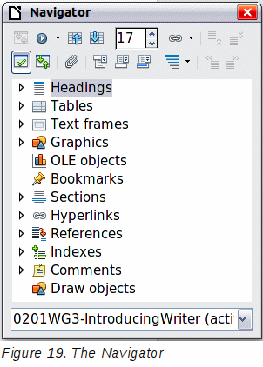
Table 1: Function of icons in the Navigator
|
|
Toggle: Not active in ordinary documents (left image). In a master document (right image), switches between the master document file and its subdocuments. |
|
|
Navigation: Opens the Navigation toolbar (see page 19). |
|
|
Previous, Next: Jumps to the previous or next item in the selected category (page, graphic, hyperlink, comment, and so on). To select the category of items, see “Using the Navigation toolbar“ on page 19. |
|
|
Page number: Jumps to the page sequence number showing in the box. Type the required page number or select it using the up and down arrows. |
|
|
Drag Mode: Select Hyperlink, Link, or Copy. See “Choosing drag mode” on page 21 for details. |
|
|
List Box On/Off: Shows or hides the list of categories. |
|
|
Content View: Switches between showing all categories and showing only the selected category. |
|
|
Set Reminder: Inserts a reminder (see page 21). |
|
|
Header/Footer: Jumps between the text area and the header or footer area (if the page has them). |
|
|
Anchor <–> Text: Jumps between a footnote anchor and the corresponding footnote text. |
|
|
Heading Levels Shown: Choose the number of heading levels to be shown. |
Moving quickly through a document
The Navigator provides several convenient ways to move around a document and find items in it:
To jump to a specific page in the document, type its sequence number in the box at the top of the Navigator.
When a category is showing the list of items in it, double-click on an item to jump directly to that item’s location in the document. For example, you can jump directly to a selected heading, graphic, or comment by using this method.
To see the content in only one category, highlight that category and click the Content View icon. Click the icon again to display all the categories. You can also change the number of heading levels shown when viewing Headings.
Use the Previous and Next icons to jump to other objects of the type selected in the Navigation toolbar. (See below for details.)
|
Tip |
Objects are much easier to find if you have given them names when creating them, instead of keeping LibreOffice’s default names of graphics1, graphics2, Table1, Table2, and so on—which may not correspond to the position of the object in the document. To rename an image, right-click on the image, select Picture → Options, and then edit the name in the dialog box. Similarly, to rename a table, right-click on the table, select Table → Table, and then edit the name. |
|
Note |
A hidden section (or other hidden object) in a document appears gray in the Navigator, and displays the word “hidden” as a tooltip. For more about hidden sections, see Chapter 4, Formatting Pages. |
To
display the Navigation
toolbar (Figure 20),
click the Navigation
icon
![]() (second icon from the left at the top of the Navigator,
Figure 19) or the small Navigation
icon near the lower right-hand corner of the document window below
the vertical scroll bar (Figure 21).
(second icon from the left at the top of the Navigator,
Figure 19) or the small Navigation
icon near the lower right-hand corner of the document window below
the vertical scroll bar (Figure 21).
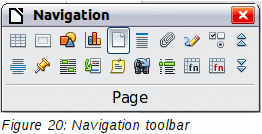
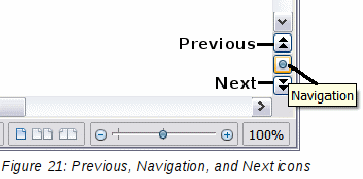
The Navigation toolbar shows icons for all the object types shown in the Navigator, plus some extras (for example, the results of a Find command).
Click an icon to select that object type. Now all the Previous and Next icons (in the Navigator itself, in the Navigation toolbar, and on the scroll bar) will jump to the previous or next object of the selected type. This is particularly helpful for finding items like index entries, which can be difficult to see in the text. The names of the icons (shown in the tooltips) change to match the selected category; for example, Next Graphic or Next Bookmark.
Rearranging chapters using the Navigator
You can rearrange chapters and move headings in the document by using the Navigator.
Click the Content View icon to expand the headings, if necessary.
(Optional) If you have several subheading levels, you can more easily find the headings you want, by changing the Heading Levels Shown selection to show only 1 or 2 levels of headings.
Click on the heading of the block of text that you want to move and drag the heading to a new location on the Navigator, or click the heading in the Navigator list, and then click either the Promote Chapter or Demote Chapter icon. All of the text and subsections under the selected heading move with it.
To move only the selected heading and not the text associated with the heading, hold down Control, and then click the Promote or Demote icon.
|
Tip |
The tooltips Promote Chapter and Demote Chapter can be misleading; all headings—whether at Level 1 (chapter) or lower—can be rearranged using this function; and the feature might be better described as Move Up or Move Down (within the document, without changing the heading level) to distinguish it more clearly from Promote Level and Demote Level, which change the heading level within the document (see below). |
To quickly change the outline level of a heading and its associated subheadings, select the heading in the Navigator, and then click either the Promote Level or Demote Level icon. This action does not change the location of the heading, only its level.
To increase the outline level of only the selected heading, but not its associated subheadings, hold down Control, and then click the icon.
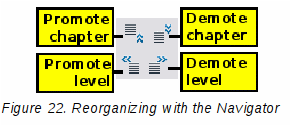
|
Note |
Users of MS Office Word will note the similarity between this functionality and Word's Outline View. |
One of the little-known features of Writer that you may find quite useful is the possibility of jumping between reminders. Reminders let you mark places in your document that you want to return to later on, to add or correct information, make some other change, or simply mark where you finished editing. The possible uses of reminders are limited only by your imagination.
To
set a reminder at the cursor's current location, click on the
![]() icon in the Navigator. You can set up to 5 reminders in a document;
setting another causes the first to be deleted.
icon in the Navigator. You can set up to 5 reminders in a document;
setting another causes the first to be deleted.
Reminders are not highlighted in any way in the document, so you cannot see where they are, except when you jump from one to the next—the location of the cursor then shows the location of the reminder.
To jump between reminders, first select the Reminder icon on the Navigation toolbar. Then click the Previous and Next icons.
To
select the drag and drop options for inserting items such as other
documents and images, into a document using the Navigator,
choose one of the following from the drop-down menu of the Drag
Mode icon
![]() .
.
Insert As Hyperlink
Creates a hyperlink when you drag and drop an item into the current document.
Insert As Link
Inserts the selected item as a link where you drag and drop in the current document. Text is inserted as protected sections. However, you cannot create links for graphics, OLE objects, references, or indexes using this method.
Insert As Copy
Inserts a copy of the selected item where you drag and drop in the current document. You cannot drag and drop copies of graphics, OLE objects, or indexes.
Writer provides several forms of help. In addition to a full Help file (reached by pressing F1 or choosing Help → LibreOffice Help from the menu bar), you can choose whether to activate tooltips, extended tips, and the Help Agent from Tools → Options → LibreOffice → General.
Placing the mouse pointer over any of the icons displays a small box, called a tooltip. It gives a brief explanation of the icon’s function. For a more detailed explanation, select Help → What’s This? and hold the mouse pointer over the icon you need more help with.
What are all these things called?
The terms used in LibreOffice for most parts of the user interface (the parts of the program you see and use, in contrast to the behind-the-scenes code that actually makes it work) are the same as for most other programs.
A dialog box is a special type of window. Its purpose is to inform you of something, or request input from you, or both. It provides controls for you to use to specify how to carry out an action. The technical names for common controls are shown in Figure 24; not shown is the list box (from which you select an item). In most cases we do not use the technical terms in this book, but it is useful to know them because the Help and other sources of information often use them.
In most cases, you can interact only with the dialog box (not the document itself) as long as the dialog box remains open. When you close the dialog box after use (usually, clicking OK or another button saves your changes and closes the dialog box), then you can again work with your document.
Some dialog boxes can be left open as you work, so you can switch back and forth between the dialog box and your document. An example of this type is the Find & Replace dialog box.
When
a document is open, you can undo the most recent change by pressing
Control+Z,
or clicking the Undo
icon
![]() on the Standard
toolbar, or choosing Edit
→
Undo from the menu bar.
on the Standard
toolbar, or choosing Edit
→
Undo from the menu bar.
The Edit menu shows the latest changes that can be undone.
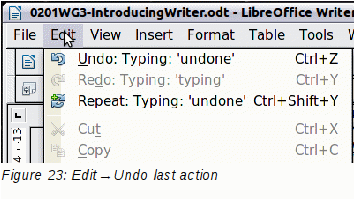
Click the small triangle to the right of the Undo icon to get a list of all the changes that can be undone. You can select multiple changes and undo them at the same time (see Figure 25).
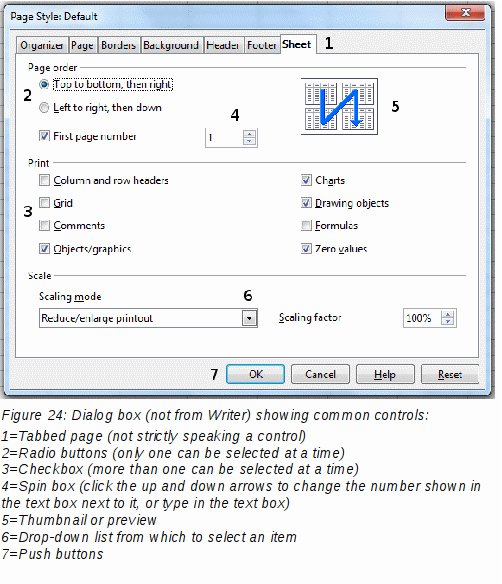
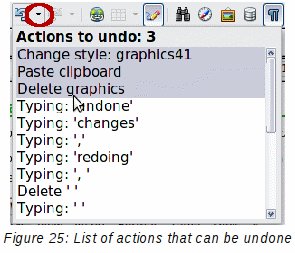
After
changes have been undone, Redo
becomes active. To redo a change, select Edit
→
Redo, or press Control+Y
or click on the Redo
icon
![]() .
As with Undo,
click on the triangle to the right of the arrow to get a list of the
changes that can be restored.
.
As with Undo,
click on the triangle to the right of the arrow to get a list of the
changes that can be restored.
1If a list style was used with a list item or heading, no dialog box appears.